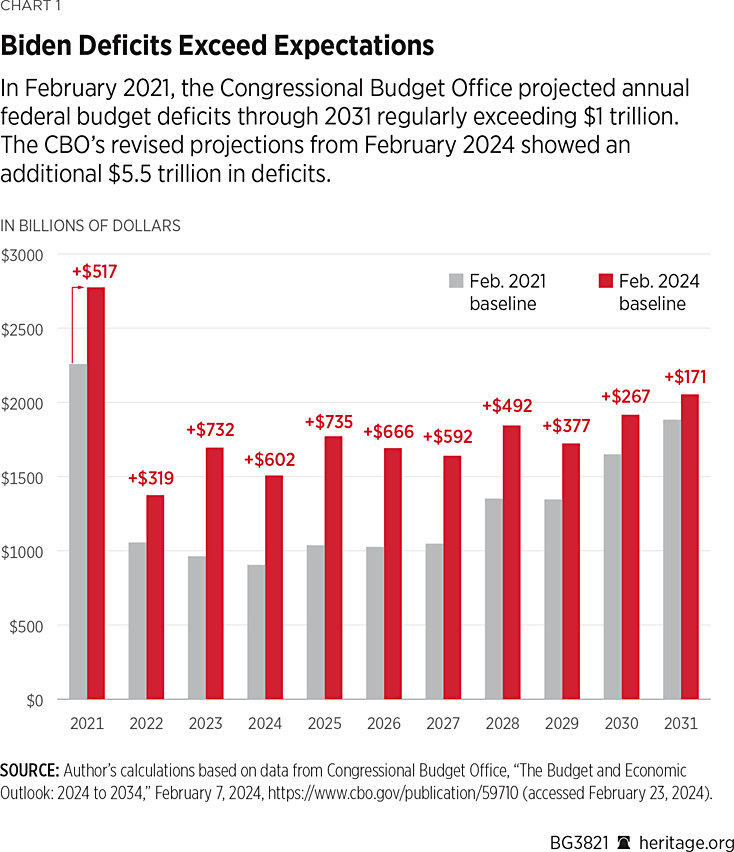The United States of America is plunging headlong into a fiscal crisis. Rising and unsustainable deficits, rapidly escalating interest payments on a mountainous national debt, and catastrophic unfunded liabilities for major benefit programs are creating a budgetary perfect storm.REF In the wake of the $7.5 trillion pandemic-era spending spree that resulted in high inflation, policymakers in Washington ought to be seeking ways to restrain the burdensome costs of the federal government.REF
Incredibly, the Administration of President Joe Biden has repeatedly chosen the opposite. Although Congress has enabled some of this damage by delegating excessive amounts of authority to the executive branch, the Biden Administration has also circumvented or outright violated federal statutes in pursuit of its left-leaning, big-spending agenda.
While many of the problems detailed in this Backgrounder flow from the radicalism of the Biden Administration, the root cause is the generations-long growth of the federal government. Restraining Washington’s budget and power is the only long-term solution to the threat of national bankruptcy.REF
Making Inflationary Deficits Worse and Funding a Leftist Agenda by Fiat
One of President Biden’s most frequent claims is that his Administration has been responsible for “record” deficit reduction. While the deficit did decline in fiscal year 2021, this was an artifact of the drop in pandemic-related spending rather than a result of fiscally responsible policy choices. In fact, by the measure that matters most—how the federal budget has performed compared to Congressional Budget Office projections when Biden took office—the nation’s fiscal situation is now $5.47 trillion worse.REF
Most of this damage is the result of spending legislation, such as the American Rescue Plan (ARP) Act, that Biden signed into law. However, a significant portion of the addition to the deficit comes from deliberate administrative spending not required by Congress, much of which goes against the spirit or letter of existing statutes.REF The Administration’s decisions in these areas stand to cost taxpayers at least $700 billion, with the amount escalating further if the plans become settled policy. Given the federal government’s unsustainable fiscal outlook and the continued strain that inflation is placing on family budgets, this ought to be a national scandal.
Student Loans. The Biden Administration has repeatedly implemented initiatives designed to reduce, delay, or eliminate the amount that borrowers must repay on federally backed student loans. These schemes have accrued a cost of roughly $370 billion to date, and include or attempted to include:REF
- A debt-cancellation plan announced in August 2022, which was poised to cost taxpayers hundreds of billions of dollars. The Supreme Court ruled that the plan was unconstitutional in June 2023 because the Administration sought to apply a narrowly targeted statute far beyond its language and purpose.REF
- Repeated extensions of the loan repayment “pause” that was initiated in 2020 in response to the pandemic. The Administration is finally transitioning away from this approach, but only through a prolonged “on-ramp” to repayments that will last through September 2024.REF
- Rewritten loan repayment rules, culminating in the Saving on a Valuable Education (SAVE) plan announced in July 2023. This plan is also legally dubious, and after accounting for interest on the debt, it could cost more than half a trillion dollars over the next decade.REF The Administration has gone so far as to fast-track the plan, moving the start date up, from July 2024 to February 2024, while also expanding the pool of eligible borrowers.REF Meanwhile, the Government Accountability Office (GAO) has warned that the Department of Education is failing to properly screen for fraudulent debt-forgiveness requests.REF
- Alteration of the income-driven repayment (IDR) plan through a regulatory change to make it more favorable to borrowers. The House passed a Congressional Review Act resolution disapproving of the rule, but Senate inaction will allow the rule to take effect.REF
- Stacking of a Department of Education regulatory panel with pro-debt-forgiveness ideologues. The panel is designed to ensure fairness and full consideration of all policy implications, but the Administration chose to put a thumb on the scale.REF
- Expansion of pre-existing programs, such as Public Service Loan Forgiveness, multiplying their cost several times over.REF
Even setting aside the judiciousness of mass student-debt cancellation (which disproportionately benefits high-income households),REF the fact that the Administration is making these moves in the absence of clear authorization is one of most egregious executive branch power grabs in U.S. history.

The COVID-19 Slush Fund. The ARP contained a $350 billion fund for state and local governments premised on “recovery” from the COVID-19 pandemic. The policy justification at the time was thin, since previous federal aid covered any state or local revenue losses and public health costs with room to spare.REF The lack of genuine budgetary hardship for states was further borne out after the ARP’s passage by countless examples of governments using the funds on boondoggles, corporate and individual welfare handouts, hiring sprees, bonuses to government workers, and so on.REF
Since state and local governments still struggled to find ways to fully exhaust such an enormous amount, it appeared that there would be money left over when the fund reached its statutory expiration in 2024. With the Biden Administration prioritizing the maximization of government spending above all else, it took the step of changing the definition of “obligated” to allow governments to spend from the fund after 2024 so long as hypothetical spending is “reported” to the Treasury Department by April 2024. This, despite the Centers for Disease Control belatedly announcing in May 2023 that the COVID-19 public health emergency was over, removing the last remaining justification for the fund.REF Additionally, the Treasury Department released guidance to make it easier for “affordable housing” projects to qualify for use of the funds.REF
While it is difficult to estimate precisely how much these changes will cost, the only question is whether the cost will be in the billions, or tens of billions, of dollars. In addition, there are material problems with the regulatory process surrounding the change, which was not deemed “major” despite its substantial implications, and which was deployed with shockingly little room for public response.REF As with the mania for writing off student loans, the Biden Administration displays a callous disregard for both the rule of law and the nation’s dire fiscal health.
Food Stamps. The Supplemental Nutrition Assistance Program (SNAP) provides taxpayer-funded food benefits to low-income households. Benefit levels are determined in part by the Thrifty Food Plan (TFP), which calculates the cost of a sufficiently nutritious diet. Historically, Congress directs updates to the TFP as part of the farm bill, and these updates tend to be cost-neutral after adjusting for inflation. However, in 2021 the Biden Administration used the TFP update to unilaterally increase the value of SNAP benefits, with an expected cost of more than $250 billion in the first 10 years.REF The GAO found procedural deficiencies in the Administration’s decision, further showing that this choice was based on ideology rather than careful deliberation.REF
Not only is the TFP change costly to taxpayers, it will also inject more demand and thus increase already-high inflationary pressures in the food sector, meaning higher prices for families that do not receive SNAP benefits.
Obamacare Expansion. In 2022, the Administration issued a rule to expand health insurance subsidies to several million people through Obamacare (officially named the Affordable Care Act). This issue, what advocates called the “family glitch,” pertains to whether a dependent with an offer of employer-sponsored family coverage is eligible for Obamacare subsidies. While some had suggested changing the determination legislatively, Congress never passed legislation. In a 2020 bill, which included the change, the cost was estimated at $45 billion over 10 years.REF The Biden Administration’s move, which even the Obama Administration rejected, was a blatant end-around of Congress, increasing deficit spending and further degrading the separation of powers.REF
Climate Agenda. Leftwing activists and their allies in Congress have advocated a massively expensive and wildly unrealistic Green New Deal for years.REF While Democrats enacted some aspects of the agenda in the inaccurately named Inflation Reduction Act (IRA), many proposed programs, subsidies, and rules could not attract sufficient support to pass through both chambers. The Biden Administration has repeatedly used executive authority to enact the remainder of the agenda by force.
The cost of the IRA’s energy provisions—in particular, subsidies for electric vehicles (EVs) and related infrastructure—has skyrocketed since the bill’s passage. The Congressional Budget Office’s estimate of these EV subsidies has already increased by $224 billion.REF One of the primary reasons is the Administration’s new regulations on vehicle emissions, which are likely to force vehicle manufacturers to produce more EVs than the market would naturally demand. Due to the IRA’s lack of limits on EV subsidies, strong-arming car manufacturers through the regulatory process leads to higher deficits.
Also on the regulatory side, a rule proposed in 2022 and set to be finalized in 2024 would require government contractors to produce time-consuming “disclosures” and plans to reduce “emissions.” This would impose untold costs on contractors and reduce the number of potential bidders (especially from smaller corporations), both of which would lead to higher prices for the federal government for the sake of negligible environmental effects. The Administration estimated that the rule would cost $3.9 billion, and there is also a broad array of significant legal and procedural problems with the rule.REF Most important, a rule of this magnitude should be based on clear statute passed by Congress rather than White House whims.
The Administration has also diverted existing funds for the sake of the “green” agenda, using the Commodity Credit Corporation (intended to support agriculture) to create a $3.1 billion “climate-smart commodities” program. This program has padded profits for corporate behemoths, such as Tyson Foods, while generating dubious environmental benefits.REF
How to Deflate Government: Recommendations for Congress
Reducing and controlling spending is perhaps the most daunting policy challenge facing the federal government.REF This is exacerbated by the continued malfeasance of the Biden Administration, which stretches statutes far beyond their text and purpose and expects that a divided Congress will be unable or unwilling to push back. While a future Administration can reverse course and undo some of the damage, the only lasting solutions to the problems cited in this Backgrounder will come from the legislative branch. Congress must:
- Use the appropriations process to defund abusive executive actions;REF
- Reduce the size and scope of the federal government to allow better oversight and provide fewer opportunities for executive branch mischief, especially in policy areas outside the federal government’s core responsibilities;REF
- Address unwarranted and harmful regulatory actions through the Congressional Review Act;REF
- Enact stronger controls on regulatory activity, such as the Regulations from the Executive in Need of Scrutiny (REINS) Act. The REINS Act would require the executive branch to receive congressional approval before a major rule can go into effect;REF and
- Rescind laws, such as the Davis–Bacon Act, and provisions, such as “Buy American” mandates, that directly increase costs for federally funded projects.REF
A failure by Congress to take action and hold the Biden Administration accountable will encourage further excesses by future occupants of the Oval Office, which the nation’s treasury cannot afford.
David Ditch is Senior Policy Analyst in the Grover M. Hermann Center for the Federal Budget at The Heritage Foundation.

